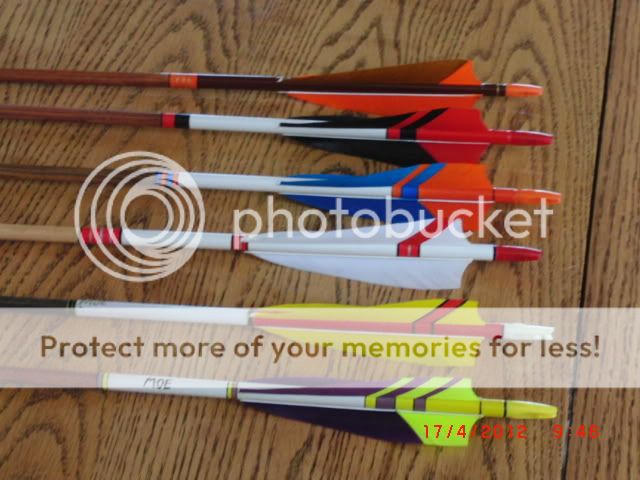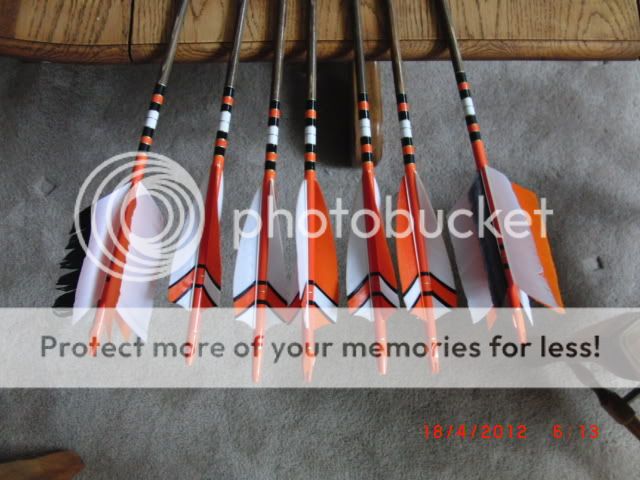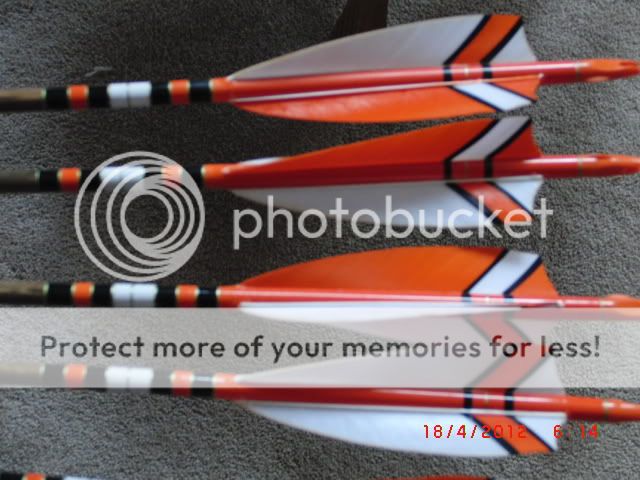Home › Forums › Bows and Equipment › Woodies
-
AuthorPosts
-
-
I have been getting into making my own wood arrows.
I want to get a little more technical on the hunting wood arrow.
Just wondering what you guys are making?
Wood type?
Tapered?
Feathers?
Tip weight?
FOC?
Total weight?
And what you hunt with that arrow?
Pics too!!??
1)Right now I am shooting Douglas Fir.
My bear/white tail hunters are 50/55 parralel, 145 tips, and trad cut 5″ feathers. Total weight is 550 gr with approx 8% FOC. (Harvested a nice spring black bear with this set up)
I played around with tip weight to 200g and got 625 total weight and 14% FOC.
2)My target/3d arrows on my other bow are Douglas Fir, parrelel, 125 gr tips with trad cut 5″ feather. Not much FOC, but they are for 3d.
I would post pics, but It wont work from my ipad 😡
-
I’ll add that with wood arrows, I am NOT a fan of EFOC or UEFOC! All my woodies are about 14% FOC with 125 grain points. As most wood shaft shooters know, wood arrows tend to break just behind the point and adding weight there just makes the problem worse. Just my feeling.
Arne
-
Moebow wrote: I’ll add that with wood arrows, I am NOT a fan of EFOC or UEFOC! All my woodies are about 14% FOC with 125 grain points. As most wood shaft shooters know, wood arrows tend to break just behind the point and adding weight there just makes the problem worse. Just my feeling.
Arne
I’m reading that more and more.
You have good luck hunting with the wood?
Ever use hard wood?
-
No, I have never used any “hardwood” shafts. I get the impression that they are harder to keep straight (just my impression) and I have no problem with that with Doug Fir or Stika or POC after finish is applied. Plus, Doug Fir produces a nice weight arrow, and is VERY strong.
Arne
-
PS. Wood is all I’ve ever hunted with. I lived in Alaska for 20 years and used wood all that time. Grew up in South Dakota in the “wood” years so wood for hunting all my life. I do use aluminum a lot for 3D, and instruction simply because they hold up better with foam targets and are easier to pull. You can have carbon, just don’t like them for anything.
-
Moebow wrote: PS. Wood is all I’ve ever hunted with. I lived in Alaska for 20 years and used wood all that time. Grew up in South Dakota in the “wood” years so wood for hunting all my life. I do use aluminum a lot for 3D, and instruction simply because they hold up better with foam targets and are easier to pull. You can have carbon, just don’t like them for anything.
I agree, I’m not a carbon fan ever since I started shooting wood. But carbon does have its place in archery.
By the way I been shooting spruce and Douglas fir. I like the fir!:o
Ever use tapered Douglas?
-
I have shot tapered ( and do have some) but I guess I’m not good enough to see that the added work of producing them or cost to buy them is worth it. Yes, they move the weight forward a little, but I just have never seen the advantage.
Arne
-
Moebow wrote: I’ll add that with wood arrows, I am NOT a fan of EFOC or UEFOC! All my woodies are about 14% FOC with 125 grain points. As most wood shaft shooters know, wood arrows tend to break just behind the point and adding weight there just makes the problem worse. Just my feeling.
Arne
Yep. 😀
-
I’ve been thinking for the last few weeks about the fact that Ishi footed his arrows. I think I’m ready to follow his example, for reasons of strength and FOC:
“The sticks thus straightened he ran back and forth between two grooved pieces of sandstone or revolved them on his thigh while holding the stones in his hand, until they were smooth and reduced to a diameter of about five-sixteenths of an inch. Next they were cut into lengths of approximately twenty-six inches. The larger end was now bound with a buckskin thong and drilled out for the depth of an inch and a half to receive the end of the foreshaft. He drilled this hole by fixing a long, sharp bone in the ground between his great toes and revolved the upright shaft between his palms on this fixed point, the buckskin binding keeping the wood from splitting.
“The foreshaft was made of heavier wood, frequently mountain mahogany. It was the same diameter as the arrow, only tapering a trifle toward the front end, and usually was about six inches long. This was carefully shaped into a spindle at the larger end and set in the recently drilled hole of the shaft, using glue or resin for this purpose. The joint was bound with chewed sinew, set in glue.”
-
wow those are some beauties. Ive never tried splicing fletching like that whats thee secret
wow those are beauties. what is the technique to splicing feathers? I been making my own wood arrows for thrity years but never tried splicing like that. Im reaslly impressed i believe id like to try that. do the spliced feathers hold up well to field use?
?
-
codger,
There are 2 ways to splice feathers. The easiest way to start is “butt splicing.” Simply cut all the way through the quill and fit carefully end to end. Then be VERY careful loading the spliced feather into the fletching clamp to get everything aligned.
The other way, is a little harder IMO but is overall better is membrane splicing. You use the quill of one feather and glue the membrane of different colors onto it.
Neither method is really hard to do BUT it DOES TAKE ATTENTION TO DETAIL!!!! AND PRACTICE. AND PATIENCE!!
Spliced feathers MAY not be quite as durable as “self” feathers but arrows get used up one way or another sooner or later.
I think if you do a search of You Tube, you may find some “build alongs” or tutorials that might give some better instruction. If folks are interested in the local area, (Northern Minnesota) I’ll work with them in person, I just don’t think I could do a viable or reasonable video on this.
Arne
-
-
AuthorPosts
- You must be logged in to reply to this topic.




